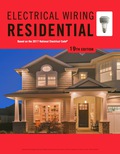
Electrical Wiring Residential
19th Edition
ISBN: 9781337101837
Author: Ray C. Mullin, Phil Simmons
Publisher: Cengage Learning
expand_more
expand_more
format_list_bulleted
Concept explainers
Question
Chapter 19.1, Problem 7R
To determine
State what is used to prevent the water from draining back into the well from the pumping equipment.
Expert Solution & Answer
Want to see the full answer?
Check out a sample textbook solution
Students have asked these similar questions
Control limits are to be established based on the average number inspected from the information in Exercise 8. What are these control limits and the central line? Describe the cases where individual control limits will need to be calculated.
Can you show why the answer is 3.55A
Can you show why the answer is 412 mA
Chapter 19 Solutions
Electrical Wiring Residential
Ch. 19.1 - Does a jet pump have any electrical moving parts...Ch. 19.1 - Prob. 2RCh. 19.1 - Where is the jet of the pump located?...Ch. 19.1 - Prob. 4RCh. 19.1 - Prob. 5RCh. 19.1 - Prob. 6RCh. 19.1 - Prob. 7RCh. 19.1 - What is compressed in the water storage tank?...Ch. 19.1 - Explain the difference between a 2-wire...Ch. 19.1 - Prob. 10R
Ch. 19.1 - Why is a 240-volt motor preferable to a 120-volt...Ch. 19.1 - How many amperes does a 1-horsepower, 240-volt,...Ch. 19.1 - What size are the conductors used for this branch...Ch. 19.1 - Prob. 14RCh. 19.1 - What provides the running overload protection for...Ch. 19.1 - What is the maximum ampere setting permitted for...Ch. 19.1 - Prob. 17RCh. 19.1 - Because the controller contains the motor starting...Ch. 19.1 - Prob. 19RCh. 19.1 - Proper pressure of the submersible pump system is...Ch. 19.1 - Fill in the data for a 16-ampere electric motor,...Ch. 19.1 - The NEC is very specific in its requirement that...Ch. 19.1 - Does the NEC allow submersible pump cable to be...Ch. 19.1 - Must the disconnect switch for a submersible pump...Ch. 19.1 - A metal well casing (shall) (shall not) be bonded...Ch. 19.2 - Prob. 1RCh. 19.2 - A major hazard involved with water heaters is that...Ch. 19.2 - Prob. 3RCh. 19.2 - The heating elements in electric water heaters are...Ch. 19.2 - An 80-gallon electric water heater is energized...Ch. 19.2 - Prob. 6RCh. 19.2 - For residential water heaters, the Consumer...Ch. 19.2 - An 80-gallon electric water heater has 60F...Ch. 19.2 - Approximately how long would it take to produce...Ch. 19.2 - Two thermostats are generally used in an electric...Ch. 19.2 - a. How many heating elements are provided in the...Ch. 19.2 - When does the lower heating element operate?...Ch. 19.2 - Prob. 14RCh. 19.2 - Prob. 15RCh. 19.2 - Prob. 16RCh. 19.2 - a. If both elements of the water heater in this...Ch. 19.2 - a. How much power in watts would the two elements...Ch. 19.2 - A condominium owner complains of not getting...Ch. 19.2 - For a single, nonmotor-operated electrical...Ch. 19.2 - A 7000-watt resistance-type heating appliance is...Ch. 19.2 - Prob. 22R
Knowledge Booster
Learn more about
Need a deep-dive on the concept behind this application? Look no further. Learn more about this topic, electrical-engineering and related others by exploring similar questions and additional content below.Similar questions
- Correlation of experimental data for the average heat transfer coefficient for turbulent flow through tubes is given by NUD =hD/k=0.023 (Rep) 0.8 (Pr) 1/3 The Reynolds number, Re₁ = πD/v, is based on the tube diameter D, the average flow velocity ū and the kinematic viscosity v. Consider the flow of air and of water through tubes of identical size. Assume that the average velocity is the same for both fluids. If the average temperature for both fluids is 80°C, determine the ratio of the heat transfer coefficient of water to that of air.arrow_forwardDon't use ai to answer I will report you answerarrow_forwardDon't use ai to answer I will report you answerarrow_forward
- help on questions about singals and systems?arrow_forwardDon't use ai to answer I will report you answerarrow_forwardI have this code in matlab: clc; n=0:8; %20 harmonic indices jn=besselj(n,5);% 5 is the modulation index jnn=abs(jn); jn1 = 20.*log10(jnn*0.5); fc=1e+6; %carrier frequency fm=10e+3; %message frequency frq1 = (fc+n.*fm)*1e-06; frq2 = (fc-n.*fm)*1e-06; frequencies = [frq2,frq1]; %Lower and upper side magnitudes = [jn1,jn1]; %Magnitude of Jn corresponding to the frequencies % Plot figure; stem(frequencies, magnitudes, 'filled'); % Stem plot for spectrum visualization title('Magnitude Spectrum of FM Signal'); xlabel('Frequency (MHz)'); ylabel('Magnitude'); grid on; I am getting the lines opposite (the line should be traced from bottom to top not from top to bottom) as shown in the picture. How can I fix this?arrow_forward
arrow_back_ios
SEE MORE QUESTIONS
arrow_forward_ios
Recommended textbooks for you
 EBK ELECTRICAL WIRING RESIDENTIALElectrical EngineeringISBN:9781337516549Author:SimmonsPublisher:CENGAGE LEARNING - CONSIGNMENT
EBK ELECTRICAL WIRING RESIDENTIALElectrical EngineeringISBN:9781337516549Author:SimmonsPublisher:CENGAGE LEARNING - CONSIGNMENT

EBK ELECTRICAL WIRING RESIDENTIAL
Electrical Engineering
ISBN:9781337516549
Author:Simmons
Publisher:CENGAGE LEARNING - CONSIGNMENT